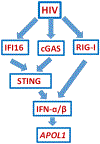APOL1 risk variants and the development of HIV-associated nephropathy
- PMID: 33340240
- PMCID: PMC8213861
- DOI: 10.1111/febs.15677
APOL1 risk variants and the development of HIV-associated nephropathy
Abstract
HIV-associated nephropathy (HIVAN) remains a concern among untreated HIV patients, notably of African descent, as patients can reach end-stage renal disease within 3 years. Two variants (G1 and G2) of the APOL1 gene, common in African populations to protect against African sleeping sickness, have been associated with an increased risk of several glomerular disorders including HIVAN, hypertension-attributed chronic kidney disease, and idiopathic focal segmental glomerulosclerosis and are accordingly named renal risk variants (RRVs). This review examines the mechanisms by which APOL1 RRVs drive glomerular injury in the setting of HIV infection and their potential application to patient management. Innate antiviral mechanisms activated by chronic HIV infection, especially those involving type 1 interferons, are of particular interest as they have been shown to upregulate APOL1 expression. Additionally, the downregulation of miRNA 193a (a repressor of APOL1) is also associated with the upregulation of APOL1. Interestingly, glomerular damage affected by APOL1 RRVs is caused by both loss- and gain-of-function changes in the protein, explicitly characterizing these effects. Their intracellular localization offers a further understanding of the nuances of APOL1 variant effects in promoting renal disease. Finally, although APOL1 variants have been recognized as a critical genetic player in mediating kidney disease, there are significant gaps in their application to patient management for screening, diagnosis, and treatment.
Keywords: Apolipoprotein (Apo)L1; HIVAN; collapsing FSGS; parietal epithelial cells; podocytes.
© 2020 Federation of European Biochemical Societies.
Conflict of interest statement
Figures



Similar articles
-
APOL1 Renal Risk Variants: Fertile Soil for HIV-Associated Nephropathy.Semin Nephrol. 2017 Nov;37(6):514-519. doi: 10.1016/j.semnephrol.2017.07.004. Semin Nephrol. 2017. PMID: 29110758 Free PMC article. Review.
-
HIV-associated nephropathy: experimental models.Contrib Nephrol. 2011;169:270-285. doi: 10.1159/000320212. Epub 2011 Jan 20. Contrib Nephrol. 2011. PMID: 21252526
-
APOL1 genetic variants in focal segmental glomerulosclerosis and HIV-associated nephropathy.J Am Soc Nephrol. 2011 Nov;22(11):2129-37. doi: 10.1681/ASN.2011040388. Epub 2011 Oct 13. J Am Soc Nephrol. 2011. PMID: 21997394 Free PMC article.
-
High risk APOL1 genotypes and kidney disease among treatment naïve HIV patients at Kano, Nigeria.PLoS One. 2022 Oct 13;17(10):e0275949. doi: 10.1371/journal.pone.0275949. eCollection 2022. PLoS One. 2022. PMID: 36227935 Free PMC article.
-
APOL1 Nephropathy: From Genetics to Clinical Applications.Clin J Am Soc Nephrol. 2021 Feb 8;16(2):294-303. doi: 10.2215/CJN.15161219. Epub 2020 Jul 2. Clin J Am Soc Nephrol. 2021. PMID: 32616495 Free PMC article. Review.
Cited by
-
Cardiac and Renal Comorbidities in Aging People Living With HIV.Circ Res. 2024 May 24;134(11):1636-1660. doi: 10.1161/CIRCRESAHA.124.323948. Epub 2024 May 23. Circ Res. 2024. PMID: 38781295 Free PMC article. Review.
-
HIV-Associated Nephropathy in 2022.Glomerular Dis. 2022 Oct 24;3(1):1-11. doi: 10.1159/000526868. eCollection 2023 Jan-Dec. Glomerular Dis. 2022. PMID: 36816427 Free PMC article. Review.
-
Identifying and Validating of an Autophagy-Related Gene Signature for the Prediction of Early Relapse in Breast Cancer.Front Endocrinol (Lausanne). 2022 Feb 16;13:824362. doi: 10.3389/fendo.2022.824362. eCollection 2022. Front Endocrinol (Lausanne). 2022. PMID: 35250881 Free PMC article.
-
Pathogenesis of HIV-associated nephropathy in children and adolescents: taking a hard look 40 years later in the era of gene-environment interactions.Am J Physiol Renal Physiol. 2024 Dec 1;327(6):F1049-F1066. doi: 10.1152/ajprenal.00208.2024. Epub 2024 Sep 26. Am J Physiol Renal Physiol. 2024. PMID: 39323389 Review.
-
The Pathology Lesion Patterns of Podocytopathies: How and why?Front Cell Dev Biol. 2022 Feb 24;10:838272. doi: 10.3389/fcell.2022.838272. eCollection 2022. Front Cell Dev Biol. 2022. PMID: 35281116 Free PMC article. Review.
References
-
- Fogo AB, Lusco MA, Najafian B & Alpers CE (2016) AJKD Atlas of Renal Pathology: HIV-Associated Nephropathy (HIVAN). Am J Kidney Dis 68, e13–e14. - PubMed
-
- Isnard-Bagnis C, Aloy B, Deray G & Tourret J (2016) Néphrotoxicité du ténofovir. Néphrologie & Therapeutique 12, 179–189. - PubMed
-
- Schwimmer JA, Markowitz GS, Valeri A & Appel GB (2003) Collapsing glomerulopathy. Semin Nephrol 23, 209–218. - PubMed
Publication types
MeSH terms
Substances
Grants and funding
LinkOut - more resources
Full Text Sources
Medical
Miscellaneous

